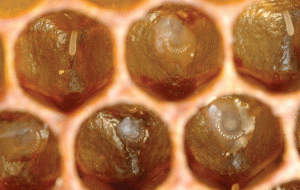Breeding Queen Bees

Breeding queen bees is not as difficult as it seems. If a colony becomes queenless, the search is on to purchase a queen before the colony produces a laying worker and subsequently dies out in roughly 40 days as worker bees slowly die out. Saving the colony is by far the number one reason why queens are purchased by hobbyists without regard for the queens genetics. Breeders, because of demand pressure, do not always carefully monitor the genetics. The result is weak queens. The queens are compromised to meet demand.
Obtain a queen that is bred locally where bees survive the pests and diseases that are common to that location or learn to raise your own queens by breeding queen bees yourself to avoid the:
- travel distance and inherent shipping stresses
- exposure to cold and hot temperatures that effect the health of the queen
- delivery carriers that may use pesticides inside a shipping terminal
- possibility of Africanized genetics from bees bred in the South
Why do queens die?
- crushed by the beekeeper
- old or inferior
- pesticides
- diseases or viruses
- insecticides
- more than one queen in a hive (except 20% of Russian colonies where two queens peacefully coexist)
- mating flight (meal for a bird, rain or cold front)
Signs a colony needs a new queen
- poor laying pattern
- only drone brood (laying worker)
- if you see queen cells: swarm cells (lower frame ) or supersedure cells (upper frame)
How to determine if a colony is queenless.
- Learn to listen to the colony. A queenless colony is louder, more agitated and busier.
- No eggs. Even when a queen is present, if there are no eggs then the hive is queenless. (Russian & Carniolans do not lay during a dearth)
- Only sealed brood present, hive has been queenless for more than a week. If there are no queen cells the colony is not able to raise its own queen. Unless there is a dearth. Carniolan and Russian queens do not lay during a dearth.
- Unsealed brood present, brood is sealed on day 8 – hive has been queenless for less than a week. Look for 3 day old eggs, if present, the colony will raise its own queen
- If you have eggs, (eggs that have not curled into larvae) the queen is somewhere in the hive
- No brood – This is an emergency. The population will continue to dwindle until the colony dies out
How to remedy a queenless colony.
- Purchase a new, mated queen (7-10 days delay in egg laying) or
- Allow the colony to raise their own queen (26-36 days delay in egg laying)
There are many ways to breed queens. Here is one step-by-step process called grafting.
Grafting
Step 1: Assemble grafting equipment
- Clean grafting tool
- Cooler with warm damp towel
- Very bright light
- Magnifiers if vision is less than 20/20
- Royal jelly (plain yogurt can be used or harvest from other cells with a hypodermic needle)
- Cell cups
- Cell frame
Step 2: Assemble a queenless cell starter nuc
- 5 frame nuc (wood or cardboard)
- 1-2 frames drawn comb (with or without brood is debated)
- 2-3 frames honey & pollen
- Pack full of young nurse bees
- Note: If a honeybee has its head pointed inside a cell she is a nurse bee cleaning out a cell.
Step 3: Select a hive for grafts
- Select a colony (disease free) (mites <1%) (over wintered 2 years) (strong honey production)
- Remove a frame with 2-3 day old larvae – brush off bees and place in cooler with damp towel
- Gently transport cooler to well-lit grafting area
- Prime the cell cup with royal jelly
- Work quickly to graft 20 cells
- The larvae must rest in the same position from cell to cell cup so that the larvae can breathe
- Place grafting frame into the cell starter nuc
- Monitor resources for 8 days. Cells should be capped by day 8.
Step 4: Assemble a mating nuc for each capped queen cell
- 5 frame nuc (wood, cardboard or Coroplast)
- 1-2 frames drawn comb (with or without brood is debated)
- 2-3 frames honey & pollen
- Plenty of honey bees
- As soon as the cells have been capped the queen cells can be moved to the mating nuc
- The nucleus hive can be sold once the queen has been laying for 21 days.
- Note: when selling queens a small mating nuc is used to quickly locate and capture the queen
Stay tuned for more information on raising your own queens.
